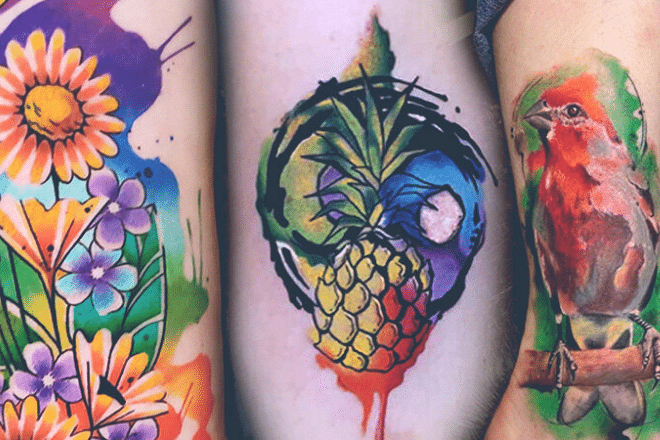Tattoos come in all sizes, colors, and shapes; and speak in several languages, but if a realistic image chock-full of vividly colored detailed features is what you have in mind, you want a watercolor style tattoo. While they are hardly new, watercolor-style tattoos are popping up — oops, bad pun — on more and more bodies.
Why Watercolor Style Tattoos Are So Popular
One of the great things about the watercolor tattoo style is that tattoos created in that style can be added to existing tattoos to give them a new life as a unique piece of permanent art that shares the features of watercolor paintings. While all images lend themselves to the watercolor style, flowers and other natural imagery tend to be the most popular subjects. However, they work well with abstracts that require airy lines and colors that flow into each other with no black outlines to ruin the mellow mood they suggest. For this reason, they work well for unconventional designs that don’t work in old-school traditional tattoos.
Recognizable Characteristics of the Watercolor Tattoo Style
The watercolor tattoo style shares much of the characteristics of the style of painting made popular by watercolor artists like Andrew Wyeth, Georgia O’Keefe, Winslow Homer, and Edward Hopper. Watercolor tattoo stylists, like these renowned masters, rely on bright pigments to create the effects that bring their subjects to life; signature techniques like color blurring, color bleeding, shading, splattering, and fading. The only difference is their medium is ink and their canvas is your skin.
The Debate Over the Watercolor Tattoo Style
Despite their vivid beauty, there is still a debate raging over the absence of defining black lines in most watercolor-style tattoos. The cons tend to be from purists who disparage anything that is non-traditional, no matter how breath-taking the finished image is, or how professionally it was created. The pros are the individuals who not only choose to opt for the watercolor tattoo style but settle for nothing else. You can judge just how big this contingent is by the number of sleeve tattoos and full body suit tattoos on display at the gym, the beach, and increasingly at places of employment when summer clothes are worn.
Dispersing the Myth Surrounding Watercolor Style Tattoos
Because they contain less ink than traditional style tattoos, and do not have black defining lines, some people think the watercolor tattoo style will fade quicker than other types of tattoos. And while there is a certain amount of fading in watercolor style tattoos, this can be a positive factor depending on the image the wearer is looking for. If you are seeking a soft subtle mood, the watercolor style will deliver it. And because this technique doesn’t depend on saturation, it won’t require frequent touch-ups, so in one sense, it’s more economical.
Caring for Your Watercolor Style Tattoo
One sign of how mainstream tattoos are becoming is the fact that Web MD has chosen to list the steps you should take after getting a tattoo. These include
- Applying a generous later of Vaseline or antibacterial ointment to protect the tattoo.
- Washing the tattoo twice a day and patting it dry before reapplying the ointment.
- Using an unscented moisturizing lotion for 2 to 4 weeks to keep it moist and protected.
- Avoiding sunlight for at least a month, (But if you are a dyed-in-the-wool beach person, once this period is over, always covering it with zinc oxide, or at the very least, a sunblocking sunscreen.)
- Lastly, if a scab develops, don’t worry about it. This is normal.
The Watercolor Tattoo Style Bottom Line
While watercolor tattoo artists don’t require special inks or tools, they do require training to acquire the skill needed to translate your ideas to skin art.













+ There are no comments
Add yours